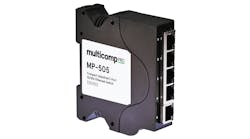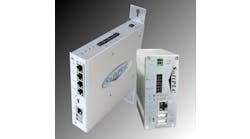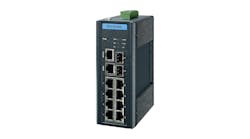After working as a semiconductor process engineer, Hank Hogan hung up his cleanroom suit and now writes about process control and other technologies from Austin.
Should you go dumb or smart? For industrial networking switches, the question isn't straightforward. Taking the less brainy option by using an unmanaged switch cuts costs and makes configuration simpler. But a managed switch, which is more intelligent, allows for new technology and applications, as well as enabling better troubleshooting and security. The last is an increasingly important concern in a connected world subject to growing cyber threats and regulation.
So, what's the basic difference between the two types of switches?
"An unmanaged switch provides you with data-network connectivity with no configuration changes. The switch powers up and it works," says Scott Mounier, regional sales engineer at Antaira Technologies.
An unmanaged switch will look at an incoming data packet and then send it on its way according to a fixed set of rules. These can involve the originating and destination address or other information contained within the header of the packet. Importantly, these forwarding rules cannot be changed.
In contrast, when using a managed switch, the rules can be altered or amended. There usually is an initial configuration, but this can be modified to accommodate a new application or to satisfy a specific need.
This basic difference shows up in a number of switch characteristics. Take cost, for example. An unmanaged switch is cheaper than a managed one. This is because an unmanaged switch may have a less powerful processor, lacks the capability to do remote configuration via a Web interface, often has less memory, and usually has fewer LEDs than the alternative. Added to that is the tendency for a managed switch to have more ports than an unmanaged one, which makes for an even greater price difference.
What's more, the configurability of managed switches carries with it a hidden cost, as well. "It adds complexity, and it is complexity that is not that familiar to an electrical engineer, for instance. It's data networking," Mounier says.
In some instances, that complexity isn't needed. For a simple network, only basic data forwarding is required. Since that situation has often been the case in a manufacturing setting in the past, it's no wonder that unmanaged switches still make up a healthy chunk of current industrial sales.
However, time and technology wait for no one, and so the days of unmanaged switches may be drawing to a close. To see why, consider an office and a plant floor that share the same physical network as a way to cut down on wiring costs.
"You don't want the plant network traffic on your office network," says Greg Philbrook, Ethernet product manager at industrial control supplier AutomationDirect. "You have the capability of separating the two into virtual separate LANs on one network with managed switches. It gives you a logical way to separate the networks."
A managed switch can support a virtual local area network (VLAN) by tagging traffic from a port. A tag will follow a packet until it reaches its destination, even if the trip involves traversing across multiple managed switches.
Another example comes from the use of a network management technique, IGMP snooping. By listening in to Internet group management protocol (IGMP) traffic, a switch can map which links need access to multicast streams. This mapping allows video, which might arise from machine vision, onto a network but segregates this multicast traffic so that it only goes where needed. Consequently, the video does not consume too much bandwidth. Again, only a managed switch can offer such a feature.
In general, for anything but simple setups, a managed switch is better than an unmanaged one, says Philbrook. As networks grow more complex and the demands on them greater, the trend will increasingly be to use managed instead of unmanaged switches, he predicts. The greater capabilities of managed switches can also help in network troubleshooting. In the case of an unmanaged switch, data flow is fixed and out of sight. This can hide problems when they arise and can make the source difficult to pinpoint, which means that the problem can drag on.
"With unmanaged switches it often happens that customers experience outages, which impacts every aspect of their business, and they have difficulty figuring out the issue and how to fix it," says Yuta Endo, senior manager for product management at Cisco Systems.
In contrast, a managed switch can be configured to do port mirroring, which duplicates traffic intended for one port and sends it to another. This can be done for all data on a switch, with the mirrored information going to what is known as a port sniffer. In effect, this is a window on the network, allowing better insight into faults, congestion and other issues.
Additionally, managed switches typically allow monitoring of the status of the switch and the status of all the ports, including the draw in a power-over-Ethernet (PoE) configuration. Knowing this data in a PoE setting can provide a warning about the health of a remote device. A managed switch may also report on its own temperature, another potential problem indicator, and the switch will also often provide its bandwidth consumption. The last could be an indication of a switch edging toward overload, which could impact the performance of the entire network.
Additionally, a managed switch, because it is a higher-dollar item that offers more connection options, is more likely to include some sort of industrial fieldbus. This provides a way to tie the switch directly into the control system and can thus provide a whole range of extra diagnostic and other information by, for example, getting the switch status information via Modbus registers.
So, an unmanaged switch may be less expensive initially. However, it could be more costly over time than a managed one, notes Shane Duffy, director of network infrastructure at B&B Electronics. Aside from cost considerations, the decision to go unmanaged or managed could come down to the value a user assigns to the network itself. "It essentially comes down to how much downtime or issues on the network can you tolerate," says Duffy.



